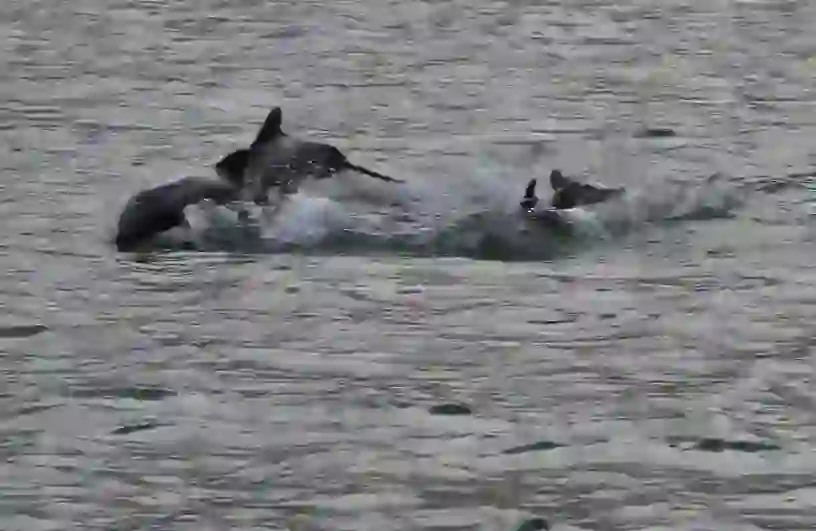
Chilean Dolphin
Chilean Dolphin
Chilean Dolphin
Off the coast of Chile, lives a small and adorable dolphin: the Chilean dolphin. They have unique characteristics and a poignant history that sets them apart from other dolphins. Let's explore the ecology of the Chilean dolphin and the efforts to protect them.
Chilean Dolphin Basic Infomation

| Property | Value |
|---|---|
| Scientific Name | Cephalorhynchus eutropia |
| Taxonomic Status | ACCEPTED |
| Rank | SPECIES |
| Vernacular Names | Chilean Dolphin |
| Kingdom | Animalia |
| Phylum | Chordata |
| Class | Mammalia |
| Order | Cetartiodactyla |
| Family | Delphinidae |
| Genus | Cephalorhynchus |
| Habitats | Chilean Coast |
| Conservation Status | Near Threatened |

Habitat
Chilean dolphins live in the shallow coastal waters of Chile, especially where rivers flow into the sea.

Size and Weight
They are about 5.6 feet (1.7 meters) long and weigh about 132 pounds (60 kilograms).

Physical Characteristics
They are characterized by their gray back and white belly, along with their rounded body shape.

Diet
They mainly eat small fish and crustaceans, and sometimes squid.

Ecology
Chilean dolphins are very social and live in small groups of 2 to 10 individuals.

Lifespan
Their lifespan is estimated to be 20 to 25 years, but there is limited data available.

Conservation Status
They are listed as Near Threatened on the IUCN Red List. Their populations are declining due to fishing and coastal development.
Chilean Dolphin Q&A

What kind of dolphin is the Chilean dolphin?
The Chilean dolphin is a small dolphin species belonging to the genus Cephalorhynchus.
They are characterized by their gray back and white belly. They are also called 'black dolphin' or 'tonina' in Spanish. They are found only off the coast of Chile, making them an endemic species. They are known to be very shy and often flee from humans. Because of this, much about their ecology remains a mystery. They form small groups, usually numbering from a few to a dozen individuals. They feed on fish and crustaceans.

What do Chilean dolphins eat?
Chilean dolphins are carnivores and primarily feed on small fish, such as anchovies and hake, as well as crustaceans like krill and crabs.
They forage for food by swimming along the shallow seabed, using echolocation to find their prey.

[Quiz!] Why are Chilean dolphin numbers declining?
The Chilean dolphin is listed as 'Near Threatened' on the IUCN (International Union for Conservation of Nature) Red List.
Their numbers are declining primarily due to human activities, such as:
・Bycatch from fisheries: They can get caught accidentally in fishing nets.
・Marine pollution: Industrial wastewater, sewage, and ship emissions are polluting their habitat and harming their food sources.
・Habitat destruction: Coastal development and environmental degradation are destroying their homes.
・Noise pollution: Noise from boats and sonar interferes with their communication and causes stress.
To protect Chilean dolphins, fishing regulations, pollution control, and habitat protection are necessary.

[Quiz!] Are Chilean dolphins kept in captivity?
Chilean dolphins are very difficult to keep in captivity.
They are shy and have difficulty adapting to human presence, so they are rarely kept in aquariums. Furthermore, they are only found in a specific region, and their population is small, making it challenging to capture them. Therefore, conservation efforts in the wild are crucial for their protection.

Would you like to become a part of the 'Animalbook.jp'?
Turn your knowledge into Q&A and share it with the world. ※Publication will be activated after purchase. Let's share information together!
Chilean Dolphin Type of List

Efforts to Protect Chilean Dolphins
- Fishing regulations: Improving fishing gear and practices, and setting catch limits to prevent accidental capture of dolphins in fishing nets (bycatch).
- Marine pollution control: Implementing various measures to prevent marine pollution caused by industrial wastewater, sewage, and ship emissions.
- Habitat protection: Establishing marine protected areas and regulating development to protect the coastal waters where Chilean dolphins live.
- Public awareness campaigns: Raising awareness about the current situation of Chilean dolphins and the importance of conservation.
Information
Congratulations! You are the first commenter!

Create Your Favorite List!
Chilean Dolphin
Save the animals you love! Build your own list to quickly revisit your favorites later.

Would you like to leave a comment?
※Please note: This is for the purchase of rights to post comments within the article.
Find Your Favorites!
Our shop offers a unique and attractive selection of goods themed around various animals.
Chilean Dolphin References
Chilean Dolphin Introduction of media used

Bobbyandck, CC BY-SA 4.0, via Wikimedia Commons

Frank Holden, CC BY-SA 3.0, via Wikimedia Commons

Sebastián Saiter V., CC BY 4.0, via Wikimedia Commons

Help Enrich Our Animalbook.jp with Your Media!
We are constantly looking to expand and enrich our Animalbook.jp with amazing photos and videos of animals. If you have any media that you'd like to share, please contribute and help us showcase the beauty and diversity of the animal kingdom. Your submissions will be credited and featured in our encyclopedia, reaching a wide audience of animal lovers.


















